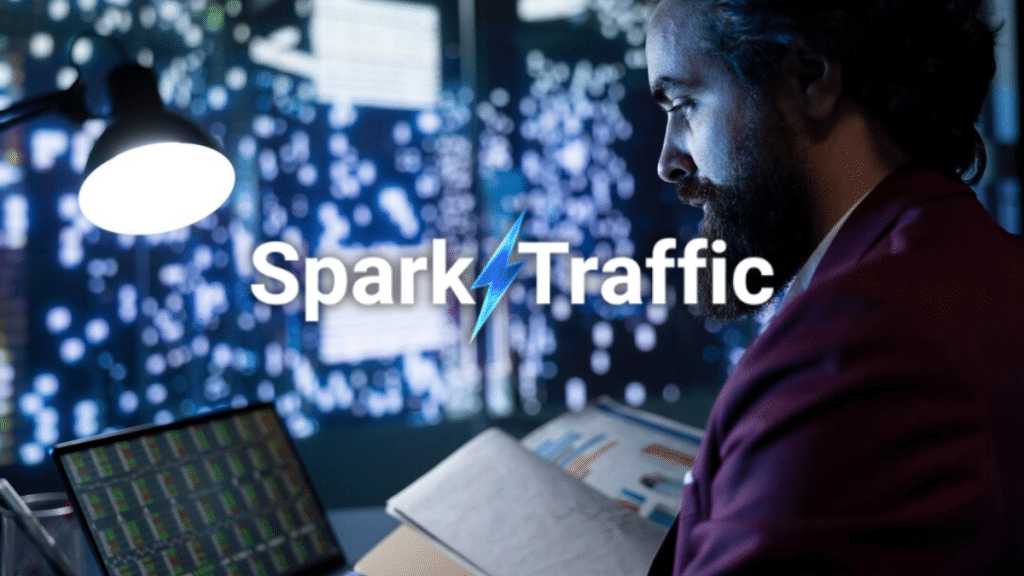In the ever-evolving world of digital marketing, web traffic isn’t just a number—it’s the pulse of your business. The higher the traffic, the stronger your visibility; ideally, your conversions are better. However, when organic growth slows or plateaus, many marketers consider traffic generation services. Naturally, concerns arise: Are these services safe? Can they harm my SEO? Specifically, many wonder: Is SparkTraffic a dangerous source for a website?
Let’s unpack this question and compare SparkTraffic to four other major platforms, using real data and insights from SparkTraffic reviews.
The SparkTraffic Model: Real or Risky?
SparkTraffic is not your average traffic bot. While the term “traffic bot” can raise red flags, SparkTraffic redefines the space with its hybrid model of simulated behavior plus real human visitors. The platform uses AI to mimic natural user actions—scrolling, clicking, navigating pages—and offers geotargeting, session control, and device emulation to make each visit look, feel, and act human.
But what truly sets it apart is the availability of live human traffic, meaning real people visiting your site, not just bots in disguise. These visits blend seamlessly with the AI-generated traffic, creating a mix that boosts numbers and enhances metrics like bounce rate, session duration, and pages per visit.
So, is it dangerous? Not at all—if used correctly.
Let’s compare it to other traffic tools on the market to see where it stands.
Babylon Traffic: Powerful But Technical
Overview: Babylon Traffic is a favorite among developers and CRO experts. It offers in-depth control over simulated behavior, supports cookie persistence, and allows users to craft complex visitor flows.
Safety: The traffic is fake but well-crafted. You could be penalized if you misuse it—say, for black-hat SEO tactics. There’s also no real human traffic, which makes it less natural in the eyes of Google Analytics.
Verdict: Powerful for experiments, but riskier for public-facing SEO strategies.
Easy Traffic Bot: Simplicity at a Cost
Overview: Designed for beginners, Easy Traffic Bot is plug-and-play. You select a URL, set limits, and watch the visits roll in. It’s great for boosting confidence or showing off page views.
Safety: The simplicity is both a blessing and a curse. Because there’s no nuanced control, it’s easy to create abnormal patterns, like 100 visits all bouncing in 5 seconds.
Verdict: Good for social proof, not for serious SEO.
10K Hits: High Volume, Low Quality
Overview: This auto-surf platform delivers thousands of visits in exchange for viewing others’ sites. It’s been around for years and is known in the Alexa Rank and traffic volume scene.
Safety: Very little behavioral realism. These visits often bounce quickly, come from limited referrers, and are easy for Google to flag.
Verdict: Risky and outdated for modern SEO needs.
TrafficZipper: More Than Just Traffic
Overview: This tool is built for affiliate marketers. It automates not just traffic, but entire marketing funnels, email sequences, and lead capture.
Safety: If misconfigured, the traffic patterns can be repetitive or overly aggressive. But for those who know how to build funnels, it can be powerful.
Verdict: Valuable for marketers, but not purely a traffic solution.
So… Is SparkTraffic Dangerous?
No—and here’s why:
- Controlled Simulation: Unlike simple traffic bots, SparkTraffic mimics real users with varied session lengths, navigation paths, and click actions.
- Human Traffic Option: Real visitors are available and can be blended with simulated ones to achieve safer, smarter growth.
- SEO-Friendly Behavior: The traffic improves key metrics like bounce rate and time-on-page, both vital to Google rankings.
- No Black-Hat Tactics: SparkTraffic does not promise ranking tricks or link wheels. It delivers authentic behavior that supports, not sabotages, your SEO.
Look at the hundreds of SparkTraffic reviews that speak to increased engagement, improved rankings, and better conversion paths.
Who Uses SparkTraffic?
- AdSense Publishers: Improve RPM and appear more competitive without violating Google’s terms.
- SEO Agencies: Test landing pages, simulate user journeys, and stabilize analytics before campaign launches.
- Affiliate Marketers: Warm up domains and increase CTRs before driving paid traffic.
- SaaS Companies: Generate early traction to appear more trustworthy to investors and users.
Best Practices: Use SparkTraffic Wisely
Even the best tools can be misused. Here’s how to stay on the safe side:
- Start with a small campaign. Monitor results before scaling.
- Blend real and simulated traffic. This creates natural flow patterns.
- Avoid manipulating click-through rates or fake conversions. Focus on engagement and visibility.
- Use analytics. SparkTraffic integrates well with Google Analytics, so track everything.
Final Takeaway: Traffic Isn’t Just a Number—It’s a Strategy
Whether you’re launching a new product or reviving an old site, the right traffic tool can make the difference between obscurity and success. But you need more than just volume—you need quality, safety, and control.
Compared to other services, SparkTraffic offers the best blend of:
- Automation and realism
- AI-driven control
- Human authenticity
- Analytics integration
It’s not dangerous. It’s smart marketing.
Still skeptical? Start with a trial, monitor your bounce rate and session durations, and watch what happens. Or just scroll through the testimonials at SparkTraffic reviews—you’ll find marketers who were once unsure, and now can’t imagine scaling without it.
